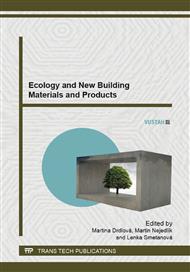[1]
Standard Test Method for Measuring the P-Wave Speed and the Thickness of Concrete Plates Using the Impact-Echo Method ASTM C1383-04(210).
DOI: 10.1520/c1383-04r10
Google Scholar
[2]
I. Kusak, M. Lunak and P. Schauer: Tracing of Concrete Hydration by Means of Impedance Spectroscopy (New Tool for Building Elements Testing). Applied Mechanics and Materials, 2013(248), 2013, pp.370-378, ISSN 1660-9336.
DOI: 10.4028/www.scientific.net/amm.248.370
Google Scholar
[3]
L. Pazdera, J. Smutny, L. Topolar, M. Korenska and V. Bilek: Non Destructive Testing during Concrete Hardening. NDT Welding Bulletin (special issue), 2010, p.18, ISSN 1213-3825.
Google Scholar
[4]
I. Plšková, Z. Chobola and M. Matysík: Assessment of Ceramic Tile Frost Resistance by Means of The Frequency Inspection Method. Ceramics-Silikáty 55 (2), 2011, pp.176-182, ISSN 0862-5468.
Google Scholar
[5]
M. Kořenská, Z. Chobola, R. Sokolář, P. Mikulková and J. Martinek: Frequency Inspection as An Assessment Tool for The Frost Resistance of Fired Roof Tiles. Proc. of Ceramics-Silikáty 50, (3), 2006, pp.185-192, ISSN 0862-5468.
Google Scholar
[6]
T. Ficker, L. Topolář and I. Kusák: Is Componential Strength Analysis of Concrete Possible?. In Magazine of Concrete Research, England, 2013, ISSN 0024-9831.
DOI: 10.1680/macr.13.00195
Google Scholar
[7]
M. Luňák, I. Kusák, L. Pazdera, L. Topolář and V. Bílek: Monitoring of Cement-based Material Solidification, Focusing on Electrical Properties. In ESA 2010. 1. CZ: Palacky University. 2010, pp.233-240. ISBN: 978-80-244-2533-7.
Google Scholar
[8]
L. Pazdera, L. Topolář, V. Bílek, J. Smutný, I. Kusák and M. Luňák: Measuring of Concrete Properties during Hardening. In ESA 2010. 1. CZ: Palacky University, 2010, pp.311-318, ISBN 978-80-244-2533-7.
Google Scholar
[9]
P. Mazal, L. Pazdera and J. Dvořáček: Application of Acoustic Emission Method. In Contact Damage Identification. International Journal of Materials & Product Technology, 41(1), 2011, pp.140-152, ISSN: 0268-(1900).
DOI: 10.1504/ijmpt.2011.040292
Google Scholar
[10]
J. Smutný and L. Pazdera: New Techniques in Analysis of Dynamic Parameters Rail Fastening. INSIGHT. Vol 46(No 10), 2004, pp.612-615, ISSN: 1354-2575.
DOI: 10.1784/insi.46.10.612.45212
Google Scholar
[11]
M. Jaśniok: Examining and modelling the influence of lengths of rebars in concrete to shapes of impedance spectra. In Cement, Wapno, Beton, Special Issue, 2012, pp.30-34, ISSN: 1425-8129.
DOI: 10.3846/skt.2011.15
Google Scholar
[12]
G. Epasto, E. Proverbio and V. Venturi: Evaluation of fire-damaged concrete using impact-echo method. Materials and Structures. Volume 43, Numbers 1-2, 2010, pp.235-245, ISSN: 1359-5997.
DOI: 10.1617/s11527-009-9484-0
Google Scholar


